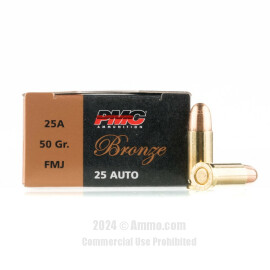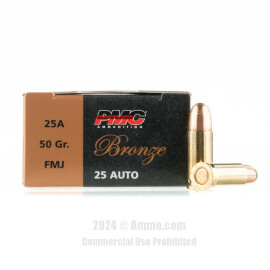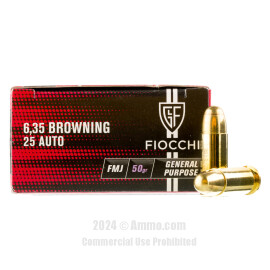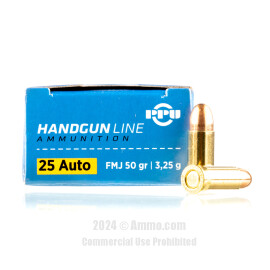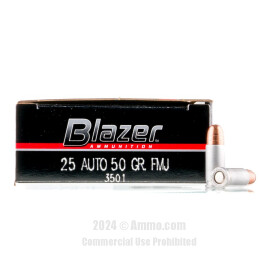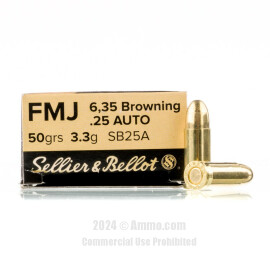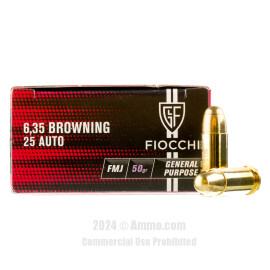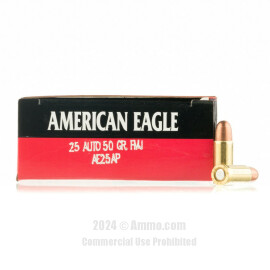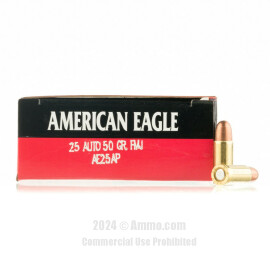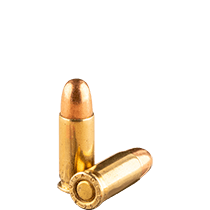
25 ACP Ammo For Sale
History of 25 ACP Ammo
First created by John Browning in 1905, the .25 Automatic Colt Pistol (ACP) is a centerfire cartridge that was designed for the Fabrique Nationale (FN) Model 1905 pistol, a vest pocket pistol made for gentlemen of the era. The firearm was released in Belgium in 1906, and quickly rose to popularity.
The .25 caliber ammo, often called .25 Auto, measures 6.35 x 16mmSR, or semi-rimmed, and is typically used in subcompact semi-automatic pistols. It features a standard 50 grain (gr) bullet that sits in a semi-rimmed, straight-walled casing and is fed into the firing chamber via a removable magazine.
Often a jacketed lead bullet, the projectile of this cartridge measures .251 inch while the case base measures .278 inch. The standard .25 ACP ammo has a .043 inch rim thickness and a rim diameter of .302 inch. The case length is .615 inch, while the overall length of the full cartridge is slightly larger than the popular .22LR at .91 inch.
While it’s not the most popular ammunition by any means, the .25 Auto is still around, even though many of its contemporary competitors have become obsolete and are now unheard of. In the modern era, many consider the .25 ACP a niche round and the cartridge continues to hold its place in the low power, low caliber ammunition world.
Development of the .25 ACP Ammo
When Browning released the .25 ACP ammunition in 1905, it was to a European audience. In 1908, the cartridge was released in the United States with the Colt Model 1908 Vest Pocket Pistol. These pistols shared the same blowback design as the 1905 original chambered for the .25 ACP. This style continues to be mimicked in most .25 ACP chambered semi-auto handguns, even today. These style of pistols were some of the first guns designed for concealed carry and were used by men who wanted to keep their firearms undetectable or to carry an undisclosed pistol for backup.
Due to their small size and low power, these pistols were often dismissed as mouse guns and considered by many too small for anything but show. Add in a series of poor quality .25 Auto chambered firearms released from Spanish and American gun companies during the early 20th century, and the cartridge’s reputation became even more damaged. However, the .25 ACP is lethal and firearms in this caliber should be treated with the same respect as larger caliber weapons.
The .25 ACP for Self Defense
Even with the mixed opinions of .25 caliber ammo, these early blowback pistols and their modern counterparts became popular for concealed carry and as purse pistols. While not the biggest cartridge or the most deadly, the .25 Auto has held its place in the world of self-defense pistols and concealed carry weapons since its inception over 100 years ago.
Due to the ammunition’s small size, firearms chambered for .25 ACP ammo are often smaller than an adult’s palm. Individuals can easily conceal the firearms on their person and these guns are often used as backups found in purses, pockets, and boots on civilians, soldiers, law enforcement, and even spies throughout the world.
The caliber may be small (the smallest centerfire ammunition in production), but it addresses and attempts to fix the common problems faced by other small-caliber rounds. Many small calibers, including the .22 Long, .22 Short, .22LR, and .17 HMR, face reliability issues because of their rimfire design. The .25 ACP is significantly more reliable than these and other rimfire cartridges, simply due to its centerfire primer.
Coming from a revolver, small-caliber ammo lacked power and had poor penetration. While the .25 cal is still a low-power round, it has a decent velocity and, with ballistic technology, reaches an average penetration of seven to 11 inches. With today’s bullets, about 25 percent of .25 ACP ammo, when hit on target, can result in an immediate incapacitation of a threat.
Now, with the era of modern ammunition, many manufacturers make .25 Auto ammo hollow point rounds and other self-defense cartridges, improving even more on the caliber’s performance and stopping ability.
Types of .25 Auto Ammo
Like other ammunitions, the .25 caliber ammo comes in different forms with different functions and purposes. Although it doesn’t come in as many varieties as more popular calibers like 9mm or .45 ACP ammo, the .25 Auto is often seen in:
- Full metal jacket (FMJ): FMJ ammo is the most common form of .25 Auto ammo for sale and features a lead bullet surrounded in a harder metal that helps the bullet keep its shape. While great for target shooting and training, FMJ is not an effective self-defense round, especially in .25 cal.
- Jacketed hollow point (JHP): The JHP bullet is hollowed, narrowing to a point in its lead center. This allows the bullet to expand on impact, creating more damage and improving stopping power. JHP is the most common self-defense .25 ACP ammo for sale today.
- Gold Dot hollow point (GDHP): Specially designed for self defense, GDHP ammunition is a hollow point cartridge formed in two stages; a pre-fluted core creates fault lines, controlling the expansion and final diameter of the bullet.
- Extreme terminal performance (XTP): Designed for self defense by Hornady, XTP bullets start as basic JHP, before having precise serration divide the bullet’s outer cover into equal segments. These serrations weaken the jacket and allow for controlled expansion, even in low-velocity ammunition.
- Glaser safety slug (SS): SS ammo features a frangible bullet, which is similar in structure to a JHP, but the hollow point is filled with bird shot. Frangible bullets are used in self defense and by law enforcement, as their penetrating power is limited and less likely to unintentionally injure bystanders due to over-penetration.
.25 ACP Ballistics
There’s no doubt that the .25 caliber ammunition is smaller than ideal for many situations, including self defense and hunting – but that doesn’t make the ammo obsolete or useless. In fact, with its mild recoil and relatively decent accuracy, the .25 ACP cartridge is reliable and durable as a backup, concealed carry weapon, last resort gun, or as a firearm for shooting small pests and vermin.
While it has a surprising velocity, averaging between 760 to 815 feet per second (fps), the delivered energy from a .25 ACP often leaves its shooter desiring more. And while its stopping power doesn’t compare to higher-caliber ammunition, the .25 ACP is still lethal, can cause significant damage to a threat, and can act as a deterrent when the situation’s needed.
When it comes to stopping power, this small cartridge doesn’t create a wound near the size made by high-power pistol ammo, like the .357 Magnum or even the .38 Special, but it can stop a threat. The average bullet wound for .25 Auto ammo has a diameter the size of a pencil and penetrates anywhere from seven to 11 inches (the length of a standard pencil is 7.5 inches). While a .25 cal bullet may not leave giant holes in a perpetrator, six or seven pencil-size holes shot through a torso definitely creates stopping power.
It should be noted that when in self-defense situations and armed with a low-caliber pistol, headshots should be avoided. These bullets may not penetrate the skull and, instead, ricochet. When this occurs, it doesn’t cause serious injury and significantly limits stopping power. Instead, aim for mid-body, particularly the chest and heart area.
Popular Firearms Chambered in .25 Auto
Many firearms have been chambered for the .25 ACP cartridge, including several revolvers, most variations of the Revolver de Poche, or Velo-dog, a small revolver used during the early 20th century to defend its user against dog attacks. The unique Lercker pistol, also designed to fire the .25 ACP, was fully automatic with a 20-round magazine and fired 1,200 rounds per minute.
Today, buyers can find a variety of antique semi-automatics chambered in .25 Auto that were manufactured in Belgium, Italy, Germany, and the former USSR. Many modern firearm manufacturers have also made guns for .25 Auto ammunition, including Kel-Tec, American Arms, Phoenix Arms, and Taurus.
Magazine-fed, .25 cal chambered firearms are available in both striker-fired and hammer-fired varieties. Some of the modern favorites include:
- Raven MP-25: A popular six-plus-one conceal carry handgun, the Raven MP-25 was often referred to as a Saturday Night Special because of its availability and low cost.
- Baby Browning: The original Baby Browning was first manufactured in 1931. And even today, more than 20 variations of the original model are still being made, especially in European countries.
- Beretta Bobcat: Manufacturing started on the user-friendly Bobcat in 1984, and this .25 cal gun is still available today, although supplies are often limited.
- Taurus PLY25: Although no longer in production, the Taurus PLY25 weighs less than 11 ounces and is smaller than many smartphones, making it an ideal option for a boot gun or backup firearm.
Popular Names for .25 ACP Ammo
Like other calibers of the time, the .25 ACP ammo is known by many names, some right and some not-so-right. Here are some of the most common terms for the cartridge:
- .25 Automatic Colt Pistol
- .25 ACP
- .25 Auto
- .25 Automatic
- 6.35mm
- 6.35mm Browning
- 6.35 x 16mmSR
- Baby Browning
There’s also the .25 North American Arms (NAA) ammo, which was first manufactured in 1999. While using the same bullet size and case length, this cartridge features a bottleneck casing, which improves its reliability.
Sometimes, people refer to the cartridge in the wrong way. They may eliminate the space between the caliber size and ammunition, such as .25ACP or .25Auto. And although the meaning is still intact, referring to the ammunition this way is grammatically wrong.
Other times, they eliminate the period before the caliber size, as in 25 ACP or 25 caliber ammo. This, too, is incorrect. The dot before the caliber is not a period, but a decimal point. Because the number represents an actual measurement, in this case .25 inch, the decimal point is necessary.
.25 ACP vs .32 ACP
If a shooter’s goal is self defense, a larger caliber is, most of the time, better. When comparing .25 ACP to .32 ACP, the differences between the two start with the bullet weight and size. The .32 offers a larger projectile that often weighs more, on average ranging from 60 to 75 gr, with variances on both ends, while the .25 ACP bullet weighs a standard 50 gr.
The .32 ACP’s velocity averages between 900 and 1,100 fps, with specialty ballistic tips reaching up to 1,815 fps. The .25 Auto, on the other hand, reaches velocities between 760 and 1,100 fps on the highest end, leading to a much lower travel speed and impact. The .32 ACP offers a muzzle velocity between 123 and 220 ft·lb, while .25 cal ammo reaches only 63 to 94 ft·lb – again, lowering its stopping power and wound sizes.
When it comes to size, the differences are rather significant, with the .32 ACP measuring 7.66 x 17mm and the .25 ACP measuring 6.35 x 16mm. While this gives the shooter a smaller bullet and less powder, it also allows for some benefits. These include a small-size firearm with the ability to hold more ammunition. The ability to conceal carry a handgun no matter what clothes a person is wearing, especially in the boot or pocket, along with the extra round or two allowed by the .25 ACP magazine. These features may make up for what the handgun lacks in energy and velocity.
Regardless what people say about the .25 ACP cartridge, American gun owners, as well as others from around the world, still find use for this hundred-year-old round today. It may not be the biggest or the strongest ammunition available, but its effectiveness, low recoil, and ability to be concealed keep it around enough that ammo manufacturers like Federal and Fiocchi continue to produce it.
FAQ
How effective is .25 ACP?
The .25 ACP can be lethal. Although it’s not the most effective cartridge and not recommended by many self-defense advocates, it still serves a role in the world of concealed carry weapons, especially in the subcompact pocket and purse pistols.
Which is more powerful, the .22 LR or the .25 ACP ammunition?
The .25 ACP is slightly less powerful than the .22 LR, but it’s significantly more reliable. While the ACP has a larger bullet, it can’t reach the velocity and energy levels of the smaller projectile. But due to its centerfire design, the .25 Auto is much less likely to fail or malfunction than the rimfire .22 LR and, therefore, recommended over the smaller cartridge for self-defense purposes.
Who made the Dickson Detective .25 ACP?
The Dickson Detective .25 ACP was manufactured by Galesi Arms, which was also known as Industria Armi Galesi. It was an Italian company that produced firearms from 1910 through 1991. Although it made some military automatic weapons, it was most known for small self-defense weapons like the Dickson Detective, which was also available in .22 Short and .22 Long.
How much does a Dickson Detective .25 ACP weigh?
Although there are differences due to grip, the average weight of the Dickson Detective .25 ACP is between nine and 10 ounces.
When was the Bauer .25 ACP made?
The Bauer .25 ACP was manufactured from 1972 through 1984 in Fraser, Michigan.
How much does a Bauer .25 ACP weigh?
Although there are some differences due to grip, the average weight of a Bauer .25 ACP is between nine and 10 ounces.
What is the best .25 ACP ammo?
The best .25 ACP ammo depends on the needs of the shooter. Full metal jacket (FMJ) ammo is great for shooting at the range, while jacketed hollow point (JHP) ammo offers more stopping power for self defense. Specialty rounds are also available like Glaser safety slugs and Hornady’s XTP.
25 ACP Ballistics: Chart of Average 25 ACP Ballistics
Note: This information comes from the manufacturer and is for informational purposes only. The actual ballistics obtained with your firearm can vary considerably from the advertised ballistics. Also, ballistics can vary from lot to lot with the same brand and type load.
| 25 ACP Bullet WEIGHT | Muzzle VELOCITY (fps) | Muzzle ENERGY (ft. lbs.) | Mid-Range TRAJECTORY (in.) | Barrel Length (in.) | |||||
|---|---|---|---|---|---|---|---|---|---|
| Muzzle | 50 yds. | 100 yds. | Muzzle | 50 yds. | 100 yds. | 50 yds. | 100 yds. | ||
| 35 Grain | 900 | 813 | 742 | 63 | 51 | 43 | n/a | n/a | 2" |
| 45 Grain | 815 | 730 | 655 | 65 | 55 | 40 | 1.8 | 7.7 | 2" |
| 45 Grain JHP | 815 | n/a | n/a | 66 | n/a | n/a | n/a | n/a | n/a |
| 50 Grain | 760 | 705 | 660 | 65 | 55 | 50 | 2 | 8.7 | 2" |
| 50 Grain FMJ | 810 | n/a | n/a | 73 | n/a | n/a | n/a | n/a | n/a |
Customer Reviews
-
elizabeth said:
well qualified
-
John said:
I ordered two calibers of ammo for handguns, .25 auto and .32 auto. Both arrived within a few days of ordering. I have fired some of the .25 auto on the target range. It performed flawlessly. The .32 auto is the same type ammo and same manufacturer. I expect it will perform as well.
-
Robert said:
Ammunition performs well in my Beretta 25
-
me said:
The .25 ammunition works perfectly.
-
Mike 561 758-8827 said:
I bought this for a Walther PPK/S. It doesn't fit. I'd like to exchange it for a case of .380 rounds. Obviously, I'll pay shipping and a restocking fee. Please call, text or email (561) 758-8827. Item Quantity Subtotal Fiocchi 9mm Ammo - 1000 Rounds of 115 Grain FMJ Ammunition 1 $399.99 Subtotal $399.99 Shipping & Handling $19.36 Tax $29.35 Gift Certificate $0.00 Grand Total $448.70
-
Donna said:
My ammo performed as expected. I will purchase ammo from ammo.com again! Thanks!
-
Robert said:
No issues, good quality ammo. No FTL or FTE issues. Very accurate. Arrived reasonably fast.
-
Kal said:
The ammo arrived within 2 days and worked perfectly.
-
Jaquon said:
Ok
-
Drummermike said:
See summary for review.
